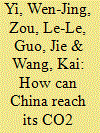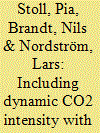|
|
|
Sort Order |
|
|
|
Items / Page
|
|
|
|
|
|
|
| Srl | Item |
| 1 |
ID:
104898


|
|
|
|
|
| Publication |
2011.
|
| Summary/Abstract |
In late 2009, the Chinese government committed to cut its carbon dioxide emissions per unit of gross domestic product (GDP) by 40% to 45% of 2005 levels by 2020. This has raised the issue of how to allocate the CO2 reduction target regionally to meet the national reduction target. To meet this objective, the following aspects may be taken into consideration: equity principles, 'common but differentiated responsibilities'; intensity reduction target fulfillment; and economic difference and reduction potential among provinces. This paper selects per capita GDP, accumulated fossil fuel related CO2 emissions and energy consumption per unit of industrial added value as indicators for emission reduction capacity, responsibility and potential, respectively. Based on these three indicators, a comprehensive index is developed and an intensity allocation model constructed. As decision makers may have different preferences when allocating the reduction burden, we allocate different weights to the indicators, analyzing the results using cluster analysis. The following aspects may also be considered together with the national regional development strategy to determine how to share the burden: the reduction potential of various regions; implementation potential of the plans; and promotion of a highly efficient low carbon economic development model.
|
|
|
|
|
|
|
|
|
|
|
|
|
|
|
|
| 2 |
ID:
124681


|
|
|
|
|
| Publication |
2013.
|
| Summary/Abstract |
In this paper we evaluate two approaches for estimating CO2 emission reduction from electricity savings: one based on average CO2 intensities of electricity generation and another that relies on marginal CO2 intensities.
It is found that the average CO2 intensity approach has a significant shortcoming when it comes to scenario-based approaches for CO2 emission reduction. This shortcoming lies in the chicken-egg problem created, where larger future electricity savings are actually big enough to change the CO2 intensity in such a way that it cannot be used anymore to estimate the CO2 emission reduction. We show that in these cases the marginal approach is preferred. To correctly apply this approach, it is important to determine the CO2 intensity of the future power mix which will not be built in order to avoid under or overestimation of the CO2 savings calculated. We propose a seven-step approach which can be used in scenario-based potential studies as guidance for estimating the CO2 emission reductions from not only electricity savings but also renewable electricity and mitigation options that consume electricity such as electric cars and heat pumps. Using our approach would avoid a disconnection of the CO2 reduction potential with the underlying reference scenario.
|
|
|
|
|
|
|
|
|
|
|
|
|
|
|
|
| 3 |
ID:
127269


|
|
|
|
|
| Publication |
2014.
|
| Summary/Abstract |
Hourly demand response tariffs with the intention of reducing or shifting loads during peak demand hours are being intensively discussed among policy-makers, researchers and executives of future electricity systems. Demand response rates have still low customer acceptance, apparently because the consumption habits requires stronger incentive to change than any proposed financial incentive. An hourly CO2 intensity signal could give customers an extra environmental motivation to shift or reduce loads during peak hours, as it would enable co-optimisation of electricity consumption costs and carbon emissions reductions. In this study, we calculated the hourly dynamic CO2 signal and applied the calculation to hourly electricity market data in Great Britain, Ontario and Sweden. This provided a novel understanding of the relationships between hourly electricity generation mix composition, electricity price and electricity mix CO2 intensity. Load shifts from high-price hours resulted in carbon emission reductions for electricity generation mixes where price and CO2 intensity were positively correlated. The reduction can be further improved if the shift is optimised using both price and CO2 intensity. The analysis also indicated that an hourly CO2 intensity signal can help avoid carbon emissions increases for mixes with a negative correlation between electricity price and CO2 Intensity.
|
|
|
|
|
|
|
|
|
|
|
|
|
|
|
|
| 4 |
ID:
103604


|
|
|
|
|
| Publication |
2011.
|
| Summary/Abstract |
This paper compares five methods to calculate CO2 intensity (g/kWh) of power generation, based on different ways to take into account combined heat and power generation. It was found that the method chosen can have a large impact on the CO2 intensity for countries with relatively large amounts of combined heat and power plants. Of the analysed countries, the difference in CO2 intensities is found to be especially large for Russia, Germany and Italy (82%, 31% and 20% differences in 2007, respectively, for CO2 intensity of total power generation).
This study furthermore shows that by taking into account transmission and distribution losses and auxiliary power use, CO2 intensity for electricity consumption is 8-44% higher for the analysed countries than the CO2 intensity for electricity generation, with 15% as global average, in 2007.
CO2 emissions from power generation can be reduced by implementing best practice technology for fossil power generation. This paper estimates a potential of 18-44% savings, with 29% as global average. An additional potential is expected to exist for reducing transmission and distribution losses, which range from 4% to 25% of power generation in 2006, for the analysed countries, with 9% as global average.
|
|
|
|
|
|
|
|
|
|
|
|
|
|
|
|
|
|
|
|
|